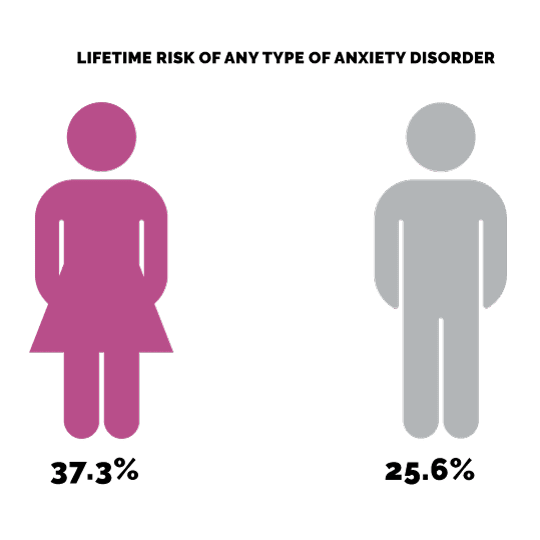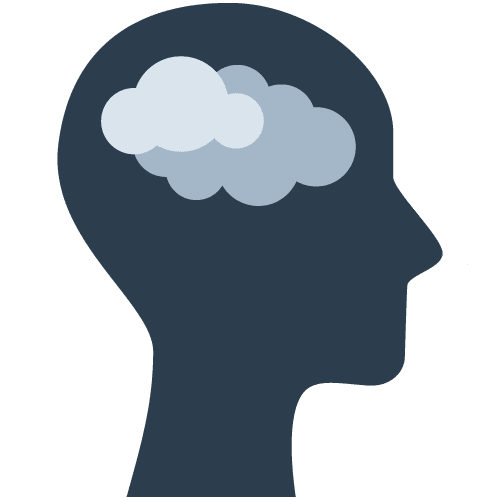Since the start of the pandemic, we have seen an increase in anxiety, not just in London, but across the globe. This is true for all age groups. Why does it matter? Anxiety and panic can have a severely negative impact on, or even ruin, a person’s life. Feeling anxious can affect your relationships with loved ones, negatively affect your physical health and self-care, disrupt work or school, and more. The good news is that there are solutions like anxiety therapy in London, in which we specialize.
So, what exactly is anxiety, and what can you do about it? In this article, we’ll explore the following:

What anxiety is
To start, let’s give a brief overview of what anxiety is and the difference between anxiety vs. anxiety disorders.
What is Anxiety?
Anxiety itself is defined by worried thoughts, feelings of tension, and for some, physical symptoms. Anyone can experience standalone anxiety, and everyone faces stress and anxiety from time to time. However, this is different from living with an anxiety disorder.
At best, anxiety is an adaptive response meant to protect us from danger. With an anxiety disorder, however, anxiety is disproportionate to the situation at hand and can cause a number of symptoms and behaviours that disrupt a person’s life.
Anxiety disorders are ongoing conditions that require professional support. For anxiety disorders like generalised anxiety disorder to be diagnosed, a person must meet the full criteria for the disorder. Generally, this will require that symptoms are clinically significant and/or impede a person’s daily life.
Therapy techniques such as emotional freedom techniques, which we will discuss later on, can help both those who live with clinical anxiety disorders and those who need help with daily life stress or other matters that impact their mental health.

What is generalised anxiety disorder (GAD)?
Generalised anxiety disorder (GAD) is the most common anxiety disorder. It affects up to around 5% of the adult population in the UK. However, kids and teens can also have GAD. GAD is characterised by excessive worry related to various topics with symptoms that last for six months or more and aren’t better attributed to another disorder or cause. Since the mind and body are so heavily connected, it is worthwhile to note that GAD is linked to various other health problems, too. These include both physical health concerns and other psychological concerns, such as insomnia, heart disease, and depression. The more severe anxiety is, the more it can impede a person’s life, health, and functioning. The severity of anxiety can be acknowledged using one of the four levels of anxiety.
What are the four levels of anxiety?
Regardless of what anxiety disorder a person has – or the source of their anxiety – it may range in severity. The four levels of anxiety are:
- Mild anxiety
- Moderate anxiety
- Severe anxiety
- Panic
Some people experience anxiety, whether mild or severe, without knowing what it is. That is one of the reasons why it’s important to spread awareness surrounding the symptoms of anxiety. Now, let’s talk about the symptoms of anxiety so that you can identify them in yourself or an individual in your care.
Some people experience anxiety, whether mild or severe, without knowing what it is. That is one of the reasons why it’s important to spread awareness surrounding the symptoms of anxiety. Now, let’s talk about the symptoms of anxiety so that you can identify them in yourself or an individual in your care.
What are the Symptoms of Anxiety?
Everyone experiences anxiety differently, which means that symptoms of anxiety can and do vary from person to person. Here are some common symptoms of anxiety:
- Excessive worry
- Hypervigilance
- Racing thoughts
- Trouble concentrating
- Rumination
- Irritability or agitation
- Insomnia (trouble falling or staying asleep)
- GI distress (e.g., nausea and stomach pain)
- Feelings of impending doom
- Shaking or trembling
- Body pain
- Muscle tension
- Heart palpitations
- Restlessness
- Sweating
- Fatigue
- Panic attacks
Panic attacks are abrupt episodes of intense fear, anxiety, or terror that often accompany physical symptoms and can be debilitating. If you experience panic attacks continuously, you could have Panic disorder, another common anxiety disorder. That said, not everyone who has a panic attack will develop panic disorder.
There’s a range of things that can trigger anxiety symptoms, including panic attacks. Now that you understand what anxiety and panic can look like, you may wonder, “what triggers anxiety?”
What triggers anxiety?

There are certain fears and worries frequently associated with feelings of anxiety. Additionally, there are known risk factors that increase the risk of specific anxiety disorders, such as GAD, panic disorder, specific phobia, or social anxiety disorder.
Common anxiety triggers include but aren’t limited to work, school, finances, problems in interpersonal relationships, and world events. These things may trigger feelings of anxiety and either trigger or worsen anxiety symptoms in an individual. Again, someone with GAD will typically worry about various issues – the anxiety won’t be limited to one topic.
One relevant piece of information is that not everyone with an anxiety disorder has generalised anxiety disorder. Someone could also have a disorder like social anxiety disorder, formerly known as social phobia, or they may have a specific phobia, which could impact a person’s unique triggers. If someone has social anxiety disorder, social situations will be their trigger.
For example, group activities, public speaking, introducing oneself to new people, and other activities that involve people you’ll be the primary trigger. On the other hand, if someone has a specific phobia, such as a phobia of heights or a phobia of bugs, being on top of a tall building or seeing a bug would be their trigger. What about risk factors for anxiety disorders? Risk factors that heighten the likelihood that a person will develop a full-blown anxiety disorder include but aren’t limited to family history, personal history of other medical conditions, and trauma or adverse experiences (such as adverse childhood experiences). That being said, anyone can develop an anxiety disorder. Note that it’s possible to live with more than one anxiety disorder. So, someone could have both GAD and panic disorder.
All in all, it’s crucial to remember that everyone’s different. This is true not just when it comes to anxiety triggers and anxiety symptoms but also the behaviours you see from the outside when someone feels anxious and doesn’t yet know how to navigate it. With that in mind, you might wonder what anxiety behaviours can look like from the outside.
Anxiety behaviours are sometimes overlooked or chalked up to another cause, and they can take place following anxiety triggers. After all, they might not be what you expect. With that in mind, it can be helpful to learn about anxiety behaviours a person might experience so that you can identify them in yourself or someone else.
Anxiety behaviours
Anxiety often comes with behaviours that feel uncontrollable. An individual may get irritable and regret it later, for example, due to unmanaged anxiety. This is one example of how anxiety can cause disruption in interpersonal relationships, which aren’t limited to romantic relationships and can also include familial relationships, friendships, colleagues, and so on. Here are some other common anxiety behaviours:
- Avoidance.
- Dissociation.
- Numbing.
Of course, these aren’t the only behaviours that show up for those who live with anxiety. Someone might also display trouble with decision making, crying, or other behaviours. Therapy and other modes of treatment can help people overcome anxiety behaviours and symptoms, ranging from behaviours like numbing and avoidance to symptoms like panic attacks and racing thoughts.
What are panic attacks?
We talked about panic attacks briefly, but what are they? As discussed previously, panic attacks refer to sudden but intense feelings of anxiety. These bouts of anxiety may last anywhere from a number of minutes to about an hour. What sets a panic attack apart from an anxiety attack is that panic attacks seemingly come out of nowhere. In contrast, anxiety attacks tend to build up over time and have an identifiable cause.
During a panic attack, an individual may experience a range of physical and psychological symptoms. These symptoms can include but aren’t restricted to sweating, shaking or trembling, feeling disoriented, hyperventilating or breathlessness, nausea, a tight chest or rapid heart rate, and feelings of dread or impending doom. Panic attacks can cause incredible distress. Some even mistake panic attacks for a heart attack or feel like they’re dying when they have one. If you have experienced multiple panic attacks or regularly experience panic attacks, you may have panic disorder.
If you suspect that you have panic disorder or another mental health condition, like GAD, make an appointment to speak with a healthcare provider, such as a primary care doctor or psychiatrist, who can diagnose mental disorders. Getting a diagnosis isn’t a bad thing, nor is it a personal flaw. In fact, getting the right diagnosis can be positive because it opens the door to getting the care you need. Now, let’s talk about what getting help for anxiety can look like.
Treating anxiety with cognitive behavioural therapy CBT vs. EFT emotional freedom technique
Even if you’ve had anxiety for a long time or haven’t found relief for another reason, such as failed treatments in the past, you can get to a better place. Those who face anxiety problems can work with a therapist to find relief. Professionals use CBT (cognitive behavioural therapy) for a range of conditions including anxiety disorders, obsessive-compulsive disorder (OCD), and post-traumatic stress disorder (PTSD).
While it’s a common treatment that can be highly effective, CBT alone is not the solution for everyone. EFT (emotional freedom techniques) can work better for treating anxiety and related disorders. Research on clinically administered EFT shows that it can lead to a significant reduction in anxiety scores. Similar to CBT, it can be used for various concerns that may pair with anxiety disorders like GAD or specific phobia, too, such as depression and PTSD. Even better, it is a non-invasive form of treatment, and you can use what you learn in therapy long after treatment.
To explain why treating anxiety through EFT can be better than CBT, it’s because EFT addresses anxiety from a whole-person perspective. What does that mean in action? EFT uses a combination of somatic stimulation (often, this is done through EFT tapping), exposure to anxiety triggers, and cognitive therapy practices, such as identifying and reframing maladaptive thoughts, to give a person well-rounded treatment. As you may notice when you review the list of anxiety symptoms above, anxiety affects both the body and mind. It makes sense, then, that a whole-person approach like EFT would be most healing and effective for so many people.
Some people seek out anxiety therapy on its own, whereas other people use a combination of treatments, such as a combination of medication and therapy. Especially for those with severe anxiety or panic-level anxiety, a combination of treatments can be crucial.
Now, the question is, where do you find anxiety therapy if you need it?
Find anxiety therapy in London
Looking for an anxiety therapist might sound intimidating, but it doesn’t have to be.
Even those who don’t have a formal diagnosis of a mental health condition such as an anxiety disorder can benefit from therapy, so in any case, don’t hesitate to give it a shot. If you’re looking for anxiety therapy in London, reach out to us today and find out how we can help.
Conclusion
What’s the bottom line? Anxiety or panic and anxiety disorders are prevalent mental health concerns experienced by individuals worldwide. In recent years, the number of people who experience anxiety symptoms that disrupt their life has continued to increase. Anxiety can affect individuals in any age group, and a range of different treatments are available for anxiety. Though modalities like cognitive behavioural therapy (CBT) are often the first line of treatment, studies suggest that other treatment options, such as emotional freedom techniques (EFT), can be more effective. EFT uses a combination of tools, such as tapping, reflecting on thoughts, and acceptance, to help people find relief from anxiety and similar concerns.